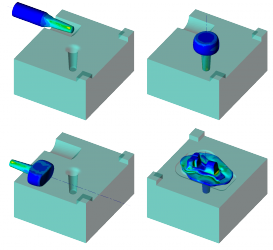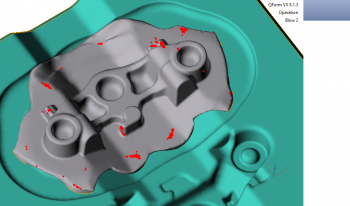Hammer forging
 Example of hammer forging simulation in QForm
Example of hammer forging simulation in QForm
Forging hammers are one of the most common machines used for forging. The most critical issues that arise during development of hammer forging technology are:
- Development of defect free forgings (ie: The absence of underfilling and defects of continuity in the die cavity as well as favorable microstructure)
- Achieving good die life
- Selecting the correct equipment and calculation of required number of blows
Advantages
- Quick technology development
- Forged part properties prediction
- Improvement of working properties and quality of the forged part
- Increasing of tool life by reducing die cracking and die wear
- Temperature distribution prediction in the tool and workpiece
 Effective stress distribution in the forged part. Simulation in QForm
Effective stress distribution in the forged part. Simulation in QForm Forged automobile part simulation in QForm. Red points indicate laps
Forged automobile part simulation in QForm. Red points indicate laps
Special QForm features which help to simulate hammer forging
- Very convenient interface allows the user to work with different variants of one technology and quickly switch between them
- A batch mode is included to solve multiple variations of a technology automatically
- Easy setup of equipment parameters
- Analysis of multiple graphs in one window
- Material can be removed from the simulated forging to show the properties of the machined part
- Special tab for multi blow forging operations allow easy setup of any number of blows in one operation including all movements (rotation and displacement) of the workpiece before a pass and variation of blow energy for each blow
- Prediction of the number of required blows
Example
The optimization of hammer forging technology using QForm simulation software is shown in this video. The technology of stub axle forging consists of 4 hammer forging operations: drawing, upsetting, flattening and final forging. Formation of the laps occurs in the initial technology as shown in the first stage of the video. Then the upsetting and flattening height have been increased to avoid defect formation. The second stage of the video shows that the forged part does not have any defects after optimization.




